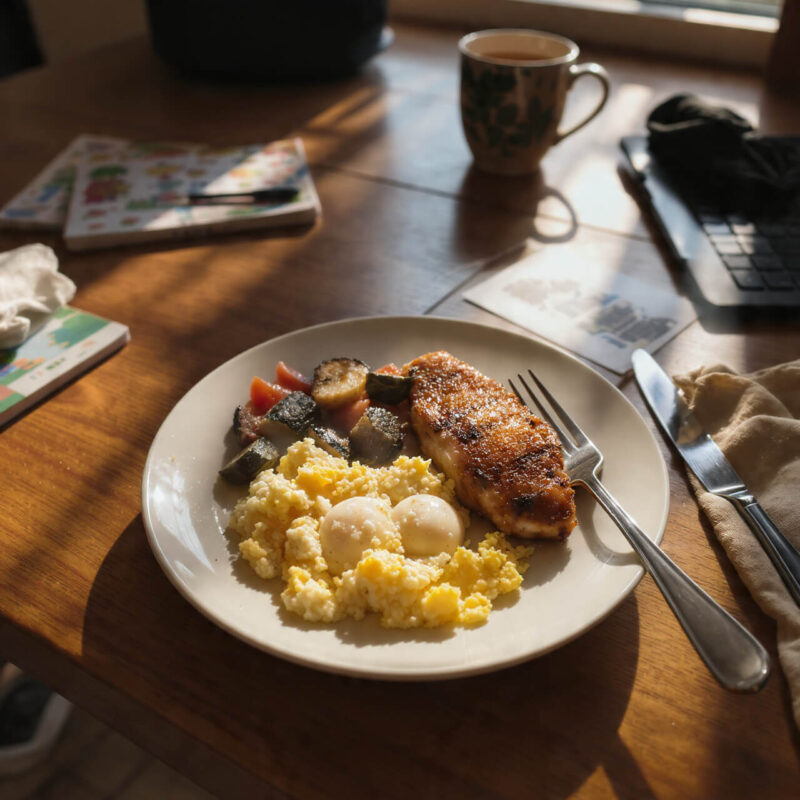Read Time: 15 Mins
Quick Summary: Why diets fail: Four out of five people regain the weight (it’s not your fault – it’s biology). How the diet industry keeps you stuck in the cycle. And most importantly: how to find YOUR eating plan and movement that actually sticks. No meal plans. No rules. Just a framework for finding what works for your body and your life.
You’re standing in front of the mirror again. Same body. Same disappointment.
Another Monday, another promise to “start fresh.”
But this time you’re wondering: “What’s actually wrong with me? Why can’t I just stick to it like everyone else seems to?”
Here’s the truth that’ll either surprise you or set you free: Nothing is wrong with you. The diet is the problem.

- The Problem: Why Diets Fail (And Why Your Brain Works Against You)
- The Cycle You’re Stuck In
- The Solution: Finding Your Path (Not Following Mine)
- Mr. Critic Moment:
- Step 1: Reframe What “Dieting” Means
- Step 2: Find Movement You Can Actually Stick To
- Step 3: Start Small and Keep Repeating
- What This Means For You
- 3 Everyday Mastery Steps
- Tiny Wins Worth Celebrating
- The Bottom Line
The Problem: Why Diets Fail (And Why Your Brain Works Against You)
Let’s talk about what’s actually happening when you diet.
The 80% Failure Rate
Here’s something that should make you stop and think: out of every five people who lose weight on a diet, four of them gain it all back within five years (according to research published in PMC).
Four out of five.
That’s not you failing. That’s the system being broken.
Why Diets Fail: The Biology
Your body doesn’t know you’re trying to fit into your jeans. It thinks you’re starving.
So it slows your metabolism, increases hunger hormones, and makes you obsess over food. This is why diets fail – your biology is literally working against restriction.
When you cut calories drastically, your body panics. It slows your metabolism to conserve energy. and increases ghrelin (hunger hormone) and decreases leptin (fullness hormone). It makes you think about food constantly.
This isn’t weakness. This is your body trying to keep you alive.
“The weight-loss industry isn’t selling solutions – it’s selling repeat customers.”
Fast or Slow? It Depends on You
Here’s something that might surprise you: research shows people who see fast results in the first month are actually five times more likely to keep the weight off long-term.
Common Misconception: Everyone should lose weight slowly. Research shows fast early results can actually predict better long-term success – but slow and steady works for others, especially if you’re building muscle at the same time.
The real point? Don’t let anyone shame you for your pace. Fast results? Great. Slow and steady while building strength? Also great. Losing weight slower because you’re gaining muscle? That’s actually smart maybe less saggy skin, more sustainable.
Your body, your timeline.
Your Body Doesn’t Want to Move (And That’s Normal)
Let’s be honest: your brain and body like comfort. Moving feels like effort. Especially when you’re tired, overwhelmed, or already feel like a failure.
So when diet culture tells you to “just exercise more,” it feels like one more thing you’re supposed to do and probably won’t.
But here’s what the research shows: people who focus on moving their bodies do better long-term than people who just cut calories.
In fact, even people who are super motivated and stick to strict calorie-cutting diets? They only keep off about 3% of their weight after five years.
This is another reason why diets fail: you can force yourself through another round of 1,200 calories a day, or you can just go for a walk.
One of those actually works long-term. The other just makes you miserable.
But movement doesn’t have to mean suffering or going the gym if you don’t want to. Doesn’t mean suffering through workouts you hate.
It just means finding something that doesn’t feel like punishment.
When Dieting Becomes the Problem
There was this eight-year study with nearly 20,000 women. Want to know what they found? Virtually no lasting weight change among dieters.
Eight years. Twenty thousand women. Nothing stuck.
And here’s something else: research shows that people who are “overweight” sometimes actually live longer than people at a “normal” BMI – when you factor in their whole lifestyle, not just the number on the scale.
So what if health isn’t about hitting a certain weight? What if it’s about how you feel, how you move, whether you can play with your kids without getting winded?
But dieting makes you obsess over the number. You skip social events because “you’ve been bad.” You hide from cameras. You measure your worth by what you ate that day.
That’s not health. That’s harm.

The Cycle You’re Stuck In
You know this pattern:
Monday: New diet. Motivated. Meal-prepped. This time will be different.
Wednesday: Hungry. Tired. Someone brought biscuits. You resist.
Friday: You slip. One biscuit becomes three. “Well, I’ve already ruined it. May as well start fresh Monday.”
Weekend: Everything you’ve been denying yourself. Haribos. Takeaway. That entire sharing bag of crisps.
Monday: Back to square one. Feeling worse than before.
The Haribos Moment
This was me: Tuesday night. Kids in bed. Husband on late shift.
I’d been “good” all week. Salad for lunch. No snacks. That gnawing, empty feeling in my stomach.
I opened the cupboard just to “check what we had.” Saw the share-size bag of Tangfastics. Told myself I’d have just a few.
Ten minutes later, the bag was empty. I hadn’t even tasted them – just chewed and swallowed on autopilot while scrolling my phone. The only thing I felt was the sugar crash coming and the shame settling in.
The Identity Trap
Every failed diet reinforces the identity: you’re “the fat one” who can’t stick to a diet anymore.
So you try harder next time. More restriction., with more rules and more punishment. More punishment.
And the guilt? The guilt is worse than the food. You eat the biscuit, feel guilty, eat three more because “you’ve already ruined it,” then restrict harder tomorrow. The cycle feeds itself.
The cycle continues.
Sound Familiar?
If you’re nodding along, you’re not alone. This is the cycle that keeps millions of people stuck.
You think everyone else has this figured out. They don’t. Four out of five people regain the weight. That’s millions of people thinking they’re the failure, when really the system is designed to fail them.
And here’s what nobody tells you: it’s not your fault.
Pause and Reflect: How many times have you started over on a Monday, convinced this time would be different?
The Solution: Finding Your Path (Not Following Mine)
Here’s what nobody tells you: the answer isn’t trying harder. It’s trying differently.
You don’t need more willpower. You need a system that works with your brain, not against it.
Let me show you how to find what actually works for you.
Mr. Critic Moment:
Mr. Critic’s Voice: “You’ve failed every diet before. Why would this time be different? You’re just lazy. You have no willpower. Everyone else can do it – what’s wrong with you?”
Here’s what Mr. Critic doesn’t want you to know: 80% of people regain the weight.
It’s not you and its not willpower. It’s biology working exactly as it’s designed to.
Mr. Critic wants you to believe you’re uniquely broken. But you’re not. You’re human. And the system is designed to fail humans.

Step 1: Reframe What “Dieting” Means
First, stop thinking about diets. Start thinking about eating plans.
The key difference? Diets have an end date. An eating plan is just how you live.
Find Your Eating Plan
This isn’t about following someone else’s rules. It’s about finding what works for your body and your life.
Questions to ask yourself:
- What foods make me feel good vs. sluggish?
- Is there an eating pattern that would fit my schedule?
- What can I actually sustain on a random Tuesday?
My eating plan? OMAD (one meal a day – eating all your food within a 1-2 hour window) wasn’t starving myself. It was letting my body burn what it already had stored. That mindset gave me freedom.
Now I stick to 80% whole foods, 20% whatever I fancy. Takeaway on Friday? Cake at parties? Chocolate when I want it? All fine. No guilt. No “I’ve ruined it.”
This is how to lose weight without feeling deprived – nothing is banned, nothing is off-limits.
Most days, I eat whole foods – things that don’t come in packets. Eggs, vegetables, meat, fish, fruit. Food that actually fills me up and keeps me going. (If you’re struggling with energy, these food swaps helped me stop feeling tired all the time. Or if you’re ready to ditch ultra-processed foods without feeling deprived, start there.)
Does OMAD work for weight loss? For me, it resulted in 2 stone down without counting a single calorie. But your plan might look completely different. You do You thats important
Your action: What could your eating plan look like? What feels sustainable for you?
Step 2: Find Movement You Can Actually Stick To
Forget “exercise.” Think: What movement doesn’t feel like punishment?
This is another reason why diets fail: they pair food restriction with forced exercise you hate. Your body rebels against both.
What Could Your Movement Be?
- Dancing in your kitchen while dinner cooks?
- Walking to the shop instead of driving?
- Cycling with your kids?
- Lifting weights for 10 minutes at home?
- Swimming because water feels good?
- Yoga because stretching feels like relief?
The only “right” movement is the one you’ll actually do.
My movement journey? I started with 20 minutes of cardio every other day and walks aiming for 6,000 steps. At first, I couldn’t do leg lifts – my stomach was in the way. In yoga, I couldn’t touch my toes.
But I kept going. Not because I was disciplined. Because I found movement that didn’t make me miserable.
Willpower got me started. Habits kept me going.
Six months later: 3.5 stone lighter.
When I plateaued, I added strength training twice a week and upped my steps to 10,000. Not because I “should” – because building muscle made me feel stronger. (Check out How to Build Muscle if that interests you.)
Final tally: 4.5 stone down. And this time? It stuck.
Pause and Reflect: What movement have you avoided because you think you’re “not good enough” at it yet? What if being bad at something was just the first step toward being okay at it?
Your action: Pick ONE form of movement. Not five. One. The one that sounds least terrible. Start with 5 minutes.
Step 3: Start Small and Keep Repeating
You don’t need a complete life overhaul. You need one tiny habit that you can repeat until it becomes automatic.
The Pattern That Actually Works:
- Pick one small thing (5-minute walk, one glass of water before coffee, 10 squats)
- Do it daily for 2 weeks (it’ll feel weird at first)
- When it feels automatic, add another small thing
- Repeat
This is how change actually sticks. Not dramatic transformations. Boring repetition.
My proof? I didn’t transform overnight. I added one thing, made it automatic, added another. Over months, not weeks.
- First: Changed what I ate (keto, then OMAD, then 80/20)
- Second: Added walking
- Third: Added strength training
- Forth: Increased steps
Each became automatic before I added the next. That’s why it stuck.
Your action: What’s your ONE thing? The smallest possible version? Do that. Just that. Make it so small you can’t fail.
What This Means For You
You don’t need my exact plan. You need your plan.
Here’s what actually makes change stick:
Stop buying repeat business. If it’s not sustainable without their products, it’s not sustainable.
Nothing is off-limits. Ask yourself: “Am I actually hungry, or am I just bored/stressed/sad?”
Change your identity. Stop being “the fat one who can’t stick to anything.” Start being someone who moves and fuels well.
Small beats big. Pick ONE tiny habit. Not five. One. Build from there. (New to this? Start with habit stacking – it’s how small changes actually stick.)
“Small, stackable changes last longer than extreme diets. Every. Single. Time.”
When you slip? It’s not failure. It’s just a comfort day. Tomorrow? Just continue. No reset needed.
When the voice whispers “It’s raining” or “You’re tired,” answer back: Grab an umbrella. Just 5 minutes.
3 Everyday Mastery Steps
Step 1: Name Your Inner Critic
Write down the exact phrases your inner critic uses when you’re struggling.
Example: “You’re too lazy. You’ll never change. Why even try?”
Now challenge them. What would you say to a friend who heard this?
Step 2: Pick One Tiny Habit
Don’t overhaul your life. Pick one small habit:
- Add 1,000 steps a day
- Swap one processed snack for whole food
- Do 5 minutes of movement before breakfast
Stack it onto something you already do.
Step 3: Track Data, Not Failure
You didn’t fail. You learned what doesn’t work for you. That’s progress.
Track what actually happens:
This is how you build self-awareness.

Journaling Prompts:
What identity have I been carrying about my body or health that is not helpful?
What’s one small habit I could start today?
Tiny Wins Worth Celebrating
Progress isn’t just about the end result. It’s about noticing the small shifts along the way.
These count as wins:
- One extra walk this week
- Ate when you were hungry, not because you were bored
- You had one less binge than last month
- No start over on Monday – you just kept going
Track your tiny wins: Use this habit tracker to record your small daily actions. Seeing your consistency builds momentum.
You’re Not Alone in This
Change is hard. Doing it alone is harder.
Strong social connection correlates with long-term success – not because someone’s watching you, but because you feel less alone in the struggle.
Surround yourself with the right voices:
When my results slowed down, what kept me going wasn’t motivation – it was having the right circle around me.
I listened to podcasts about health, muscle building, sustainable eating and read books that reinforced what I was learning. I joined communities where people talked about progress, not perfection.
You don’t need to do this alone. And you don’t need to rely only on your own willpower. Build a circle of voices – even if they’re in your earbuds – that remind you this is possible.
Ways to build your circle:
- Listen to podcasts that talk about health as a practice, not a before/after
- Read books that reinforce habits over hacks (not diet books)
- Join Facebook groups focused on sustainable habits, not quick fixes
- Participate in community challenges that focus on consistency, not perfection
And if you need support or just want to share what’s working (or not working) for you, drop a comment below. I read every one and I’m always happy to help.
You don’t have to figure this out alone.
The Bottom Line
There’s no one-size-fits-all solution.
Find an eating plan (not a diet) that works for you. Build it into your identity.
- If you snack at night, don’t keep snacks at home.
- If portions are your issue, reduce them.
- Add 1,000 steps a day.
- Be 1% better than yesterday.
That’s how change sticks.
If I could go back and tell my old self anything, it would be this:
Start small. Build habits. Move more. And stop waiting for Monday.
Because why diets fail is clear: they work against your biology, your psychology, and your identity. But an eating plan you actually enjoy? That lasts.
This is your permission slip to start messy.
We don’t chase perfect here we practise progress, because that’s Everyday Mastery
If you enjoy these posts and want to support the writing, you can buy me a coffee it keeps the kettle (and the ideas) warm.
Join the Everyday Mastery newsletter calm, practical insights to help you build small daily wins that last.
Kel is the writer behind Everyday Mastery, where she shares the real, messy, and meaningful process of building habits, resilience, and self-belief from the ground up. Her writing blends ancient philosophy with modern science, always focused on small, practical steps that lead to lasting





